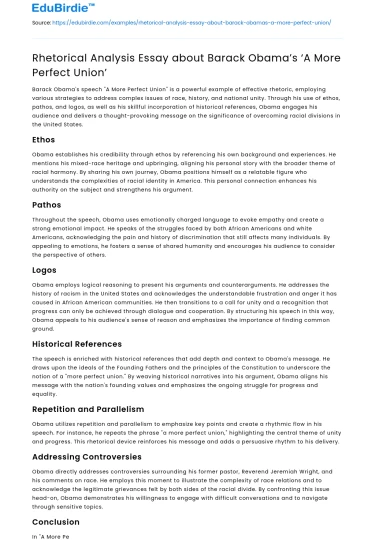Barack Obama's speech "A More Perfect Union" is a powerful example of effective rhetoric, employing various strategies to address complex issues of race, history, and national unity. Through his use of ethos, pathos, and logos, as well as his skillful incorporation of historical references, Obama engages his audience and delivers a thought-provoking message on the significance of overcoming racial divisions in the United States.
Ethos
Obama establishes his credibility through ethos by referencing his own background and experiences. He mentions his mixed-race heritage and upbringing, aligning his personal story with the broader theme of racial harmony. By sharing his own journey, Obama positions himself as a relatable figure who understands the complexities of racial identity in America. This personal connection enhances his authority on the subject and strengthens his argument.
Save your time!
We can take care of your essay
- Proper editing and formatting
- Free revision, title page, and bibliography
- Flexible prices and money-back guarantee
Pathos
Throughout the speech, Obama uses emotionally charged language to evoke empathy and create a strong emotional impact. He speaks of the struggles faced by both African Americans and white Americans, acknowledging the pain and history of discrimination that still affects many individuals. By appealing to emotions, he fosters a sense of shared humanity and encourages his audience to consider the perspective of others.
Logos
Obama employs logical reasoning to present his arguments and counterarguments. He addresses the history of racism in the United States and acknowledges the understandable frustration and anger it has caused in African American communities. He then transitions to a call for unity and a recognition that progress can only be achieved through dialogue and cooperation. By structuring his speech in this way, Obama appeals to his audience's sense of reason and emphasizes the importance of finding common ground.
Historical References
The speech is enriched with historical references that add depth and context to Obama's message. He draws upon the ideals of the Founding Fathers and the principles of the Constitution to underscore the notion of a "more perfect union." By weaving historical narratives into his argument, Obama aligns his message with the nation's founding values and emphasizes the ongoing struggle for progress and equality.
Repetition and Parallelism
Obama utilizes repetition and parallelism to emphasize key points and create a rhythmic flow in his speech. For instance, he repeats the phrase "a more perfect union," highlighting the central theme of unity and progress. This rhetorical device reinforces his message and adds a persuasive rhythm to his delivery.
Addressing Controversies
Obama directly addresses controversies surrounding his former pastor, Reverend Jeremiah Wright, and his comments on race. He employs this moment to illustrate the complexity of race relations and to acknowledge the legitimate grievances felt by both sides of the racial divide. By confronting this issue head-on, Obama demonstrates his willingness to engage with difficult conversations and to navigate through sensitive topics.
Conclusion
In "A More Perfect Union," Barack Obama employs a skillful combination of ethos, pathos, and logos to deliver a poignant message on the importance of unity and progress in overcoming racial divisions. Through his personal experiences, historical references, and rhetorical strategies, Obama engages his audience and encourages them to confront the challenges of the past while striving for a more inclusive and harmonious future. The speech stands as a testament to his ability to inspire and connect with people on a profound level.






 Stuck on your essay?
Stuck on your essay?

